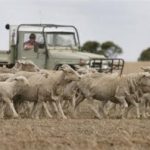 Cows flatulence, clearing forests for pastures, the manufacturing of fertilizers to grow cattle feed, and transporting beef to supermarkets, all produce even more greenhouse gases which makes this industry as worse as the carbon emissions of coal fired power plants.
Cows flatulence, clearing forests for pastures, the manufacturing of fertilizers to grow cattle feed, and transporting beef to supermarkets, all produce even more greenhouse gases which makes this industry as worse as the carbon emissions of coal fired power plants.
The cows produce Methane (CH4), a greenhouse gas that remains in the atmosphere for approximately 9-15 years. Methane is over 20 times more effective in trapping heat in the atmosphere than carbon dioxide (CO2) over a 100-year period.
In Australia, the government said that livestock flatulence accounts for about 12% of the country’s annual greenhouse gas emissions, and has recently announced a multi-million dollar investment in research on reducing gas emissions from farm animals as part of the fight against global warming.
So before you consume that well-done steak, think how much greenhouse gas has been emitted into the environment for you to enjoy a good dinner.